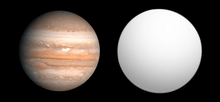WASP-11b/HAT-P-10b
WASP-11b/HAT-P-10b or WASP-11Ab/HAT-P-10Ab[3] is an extrasolar planet discovered in 2008. The discovery was announced (under the designation WASP-11b) by press release by the SuperWASP project in April 2008 along with planets WASP-6b through to WASP-15b, however at this stage more data was needed to confirm the parameters of the planets and the coordinates were not given.[4] On 26 September 2008, the HATNet Project's paper describing the planet which they designated HAT-P-10b appeared on the arXiv preprint server.[1] The SuperWASP team's paper appeared as a preprint on the Extrasolar Planets Encyclopaedia on the same day, confirming that the two objects (WASP-11b and HAT-P-10b) were in fact the same, and the teams agreed to use the combined designation.[2]
 Size comparison of WASP-11b/HAT-P-10b with Jupiter. | |
| Discovery | |
|---|---|
| Discovered by | West et al. (SuperWASP) Bakos et al. (HATNet) |
| Discovery site | SAAO |
| Discovery date | April 1, 2008 (announced) September 26, 2008 (preprints) |
| Transit | |
| Orbital characteristics | |
| 0.0439+0.0006 −0.0009[1] AU | |
| Eccentricity | 0[1] |
| 3.7224690 ± 0.0000067[1] d | |
| Inclination | 88.5 ± 0.6[1] |
| Semi-amplitude | 69.1 ± 3.5[1] |
| Star | WASP-11/HAT-P-10[2] |
| Physical characteristics | |
Mean radius | 1.045+0.050 −0.033[1] RJ |
| Mass | 0.460 ± 0.028[1] MJ |
Mean density | 498 ± 64 kg/m3 (839 ± 108 lb/cu yd)[1] |
| 10.5 m/s2 (34 ft/s2)[1] | |
| Temperature | 1030+26 −19[1][note 1] |
The planet has the third lowest insolation of the known transiting planets (only Gliese 436 b and HD 17156 b have lower insolation). The temperature implies it falls into the pL class of hot Jupiters: planets which lack significant quantities of titanium(II) oxide and vanadium(II) oxide in their atmospheres and do not have temperature inversions.[5] An alternative classification system for hot Jupiters is based on the equilibrium temperature and the planet's Safronov number.[note 2] In this scheme, for a given temperature, class I planets have high Safronov numbers and tend to be in orbit around cooler host stars, while class II planets have lower Safronov numbers.[6] In the case of WASP-11b/HAT-P-10b, the equilibrium temperature is 1030 K[note 1] and the Safronov number is 0.047±0.003, which means it is located close to the dividing line between the class I and class II planets.[1]
The planet is in a binary star system, the second star is WASP-11 B, with a mass 0.34 ±0.05 of the Sun and a 3483 ±43 temperature.[7]
Notes
- Assumes the planet has zero albedo. Its secondary transit of the planet behind its star has not yet been observed and so the temperature provided is a hypothetical "equilibrium temperature".
- The Safronov number is defined as
See also
References
- Bakos, G. Á.; et al. (2009). "HAT-P-10b: A Light and Moderately Hot Jupiter Transiting A K Dwarf". The Astrophysical Journal. 696 (2): 1950–1955. arXiv:0809.4295. Bibcode:2009ApJ...696.1950B. doi:10.1088/0004-637X/696/2/1950.
- Schneider, J. "Notes for star WASP-11/HAT-P-10". The Extrasolar Planets Encyclopaedia. Archived from the original on 2008-10-01. Retrieved 2008-09-29.
- West, R. G; Collier Cameron, A; Hebb, L; Joshi, Y. C; Pollacco, D; Simpson, E; Skillen, I; Stempels, H. C; Wheatley, P. J; Wilson, D; Anderson, D; Bentley, S; Bouchy, F; Enoch, B; Gibson, N; Hébrard, G; Hellier, C; Loeillet, B; Mayor, M; Maxted, P; McDonald, I; Moutou, C; Pont, F; Queloz, D; Smith, A. M. S; Smalley, B; Street, R. A; Udry, S (2011). "The HARPS search for southern extra-solar planets XXXIV. Occurrence, mass distribution and orbital properties of super-Earths and Neptune-mass planets". arXiv:1109.2497 [astro-ph.EP].
- "WASP Planets". SuperWASP. Retrieved 2016-01-26.
- Fortney, J. J.; et al. (2008). "A Unified Theory for the Atmospheres of the Hot and Very Hot Jupiters: Two Classes of Irradiated Atmospheres". The Astrophysical Journal. 678 (2): 1419–1435. arXiv:0710.2558. Bibcode:2008ApJ...678.1419F. doi:10.1086/528370.
- Hansen, B. M. S. & Barman, T. (2007). "Two Classes of Hot Jupiters". The Astrophysical Journal. 671 (1): 861–871. arXiv:0706.3052. Bibcode:2007ApJ...671..861H. doi:10.1086/523038.
- Open Exoplanet Catalogue WASP-11 20b
External links
![]()